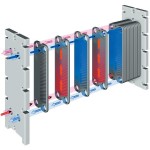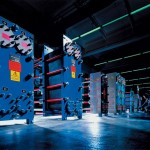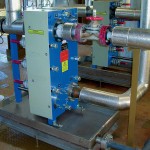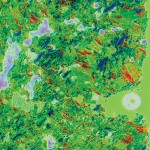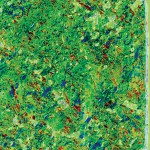Conventional graphite heat exchangers have many advantages but are relatively difficult to maintain and require a lot of space. Therefore, compact heat exchangers with plates made from Diabon NS1 or NS2 are increasingly being considered by users. In practice, these devices not only feature impressive performance, but also offer long service times and exceptional service- ability, as confirmed by reports.
Harald Mair, Kees Versluis
With highly corrosive media such as hydrochloric acid, hydrofluoric acid and sulphuric acid, the use of shell-and-tube and block heat exchangers made from process equipment graphite has been widespread for many decades. Recently, the very compact and adaptable graphite plate heat exchangers have increased in significance. This is particularly true of boards made from impregnated process equipment graphite (Diabon NS1 or Diabon NS2) or non-porous fluoropolymer composite finest-grain graphite (Diabon F100).
Heat exchangers with plates made from Diabon NS1 or NS2 were brought onto the market by the SGL Group in 1994. A user from the outset, Hexion Specialty Chemicals BV in Pernis in the Netherlands, confirms its own consistently positive long-term experience with these products. Teijin Aramid BV, based in the Dutch town of Emmen, is equally impressed by the overall performance of these products. Following an extended test period, this company recently decided to install graphite plate heat exchangers. Both companies subject the heat exchangers to highly corrosive media and operate the product on a continuous basis.
Graphite impregnated with phenol resin
Diabon plate heat exchangers, a joint development from SGL Group and Alfa Laval, are modular in design and equipped with a sealed plate packet. Both media are fed into this packet’s channels in opposing directions. Diabon NS1 or NS2 products do not just have a corrosion-resistant plate material but also feature a turbulent free-flow plate profile, and the channels are sealed with thin film-like PTFE seals.
The Diabon NS1 and NS2 graphite materials used are electrographites, whose open pores are sealed with a phenol resin. This makes the process equipment graphite impermeable to liquid. The two materials differ in terms of size and the distribution of (closed) pores. Diabon NS2 has a smaller central pore size and a more evenly spaced pore distribution than Diabon NS1.
This ensures superior flexibility and tensile strength as well as increased corrosion resistance.
The milled free flow profile minimises the tendency to clog and ensures a low pres-sure drop and high heat conductivity. Only a very small part of the surface of the film-like PTFE seals is exposed to the aggressive media, which helps prevent premature seal corrosion.
Heat transfer coefficients (k values) of 4000 W/(m2 K) are achieved in practice. The fluid media flow volumes are limited to approximately 85 m3/h by the size of the flange connections (DN 100). The products can be operated at temperatures of up to 200 °C and are designed for a pressure of up to 8 bar (Pressure Equipment Directive 97/23/EC and AD 2000 regulations).
Thanks to their design, Diabon plate heat exchangers exhibit considerable advantages over other types of graphite heat exchangers. Without any change to the standard configuration, they can be subjected to corrosive materials on both sides, need less space, are adaptable to changing conditions (such as increased flows and greater thermal heat load), work with a smaller filled amount and are easy to maintain. Since only standardised parts which are always in stock are used, it is also possible to replace defective parts quickly during servicing.
Long-term experiences: Hexion Specialty Chemicals
Hexion Specialty Chemicals BV, a well-known manufacturer of thermosetting resins, operates a hydrogen chloride cleansing and drying facility in part of its factory in Pernis. Since 1995, the company has employed two P40 graphite plate heat exchangers at this facility to pre-heat a so- lution containing 30 % hydrochloric acid from 35 °C to 118 °C using a hot solution containing 18 % hydrochloric acid, which is cooled down from 138 °C to 68 °C. Both plate heat exchangers contain 51 graphite plates with a 5-pass configuration on each side. They are designed for a pressure of 8 bar and a thermal output of 1023 kW.
The two graphite plate heat exchangers replaced three outdated graphite block heat exchangers. The old products were sensitive to fluctuations in pressure and temperature and would quickly start leaking. After an average of six months, repairs had to be made, which entailed long periods of downtime. On average, Hexion incurred annual repair costs of around sixty to eighty thousand euros.
When another cost-intensive repair loomed on the horizon in 1995, SGL Group proposed replacing the block heat exchangers with modern plate heat exchangers with free flow plates made from Diabon NS1, which had only been on the market for a short period of time. During the service life it became clear that both media contained traces of a strong oxidising agent which would reduce the life expectancy of the plates considerably. For this reason, Diabon NS2 was used instead. This is considerably more resistant under these conditions.
“With Diabon NS2 plates, maintenance has only been necessary every four years, which entailed replacing the seals. When maintenance is due, we send the apparatus to SGL Group. We always received the heat exchangers back within no more than a few days. Having them serviced by the manufacturer is much more cost-effective than servicing them ourselves”, says Rob de Graaf, the engineer responsible for the HCl facility at Hexion. “For short-term repairs, we used SGL’s on-site service, where the products are repaired directly in the machine.”
Completion of test phase at Teijin Aramid
Teijin Aramid BV is known worldwide as a manufacturer of aramid fibres. In one stage of the process, a solution of 30 % to 35 % sulphuric acid is heated from 50 °C to 75 °C in heat exchangers using water pressure/condensation. In late 2004 to early 2005, the company replaced one of its graphite block heat exchangers with a P25 graphite plate heat exchanger as a test. This product features 15 free flow plates made from Diabon NS2 with a 3-pass configuration on each side. The hot service medium is cooled from 140 °C to 85 °C. Teijin Aramid hoped to achieve a longer service life as well as – in the event of leakages – simpler and quicker repairs than with block heat exchangers.
After 35 months, the test phase was over and operation of the products was interrupted according to plan in order to check the condition of the graphite plates. The graphite plates which were removed were examined by both the SGL Group and Akzo Nobel Material Center (AMC), a division of the aramid manufacturer’s former parent company. All the tests showed unanimously that the side of the plate heat exchangers which came into contact with sulphuric acid was corroded on the surface, but this did not affect the product’s seal or function.
Photomicrographs show that the sulphuric acid penetrated the phenol resin impregnation and destroyed the resin to an average depth of only 0.7 mm (typically between 0.3 and 1.0 mm). The cause of this was hydrogen peroxide in the process medium.
Teijin Aramid has been using both P25 graphite plate heat exchangers for over three years without any repair or mainte-nance being necessary. The company intends to continue installing graphite plate heat exchangers and has already ordered more products.
cpp 433
Diabon plate heat exchanger
EuroMold 2008
Share:



